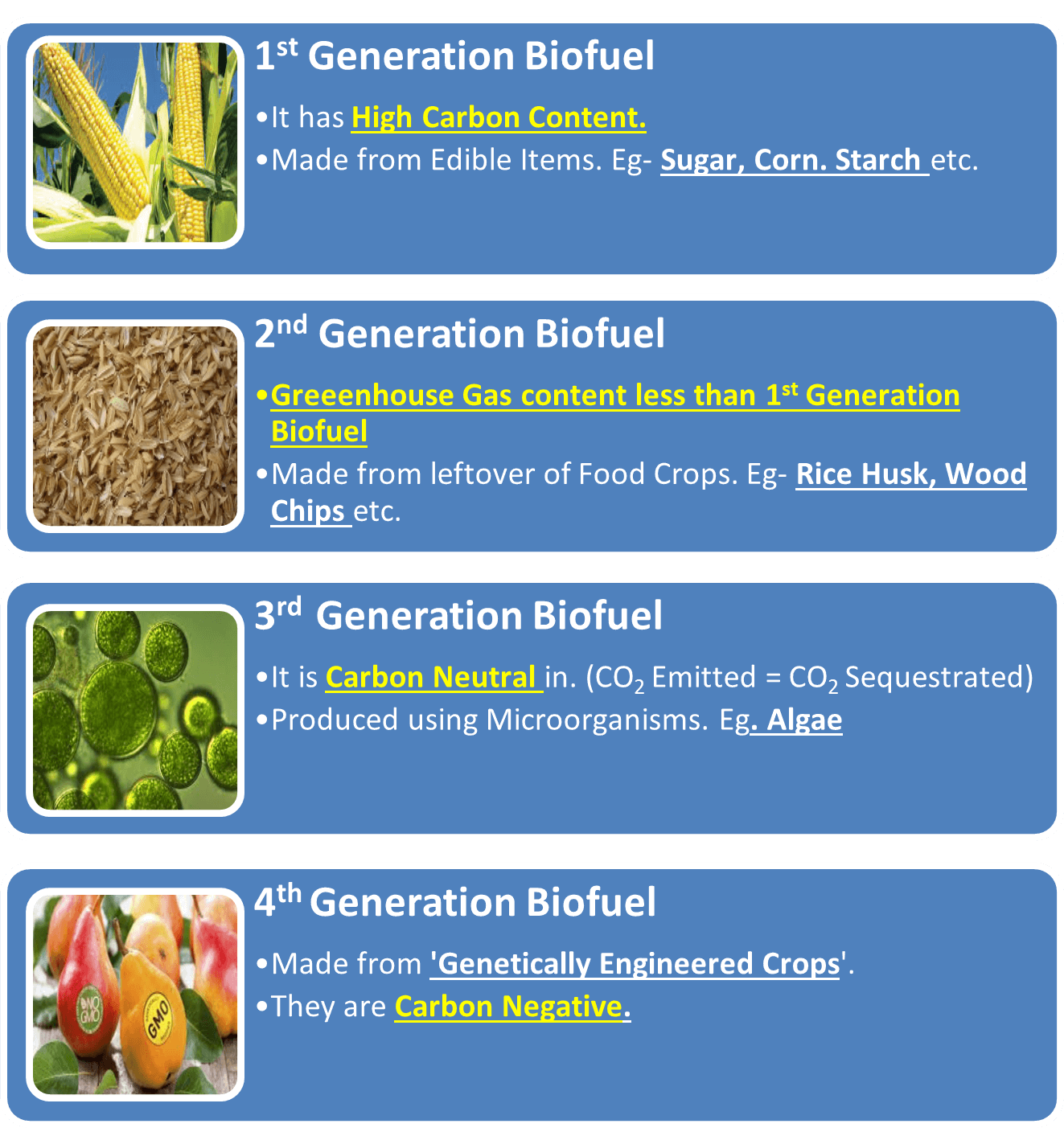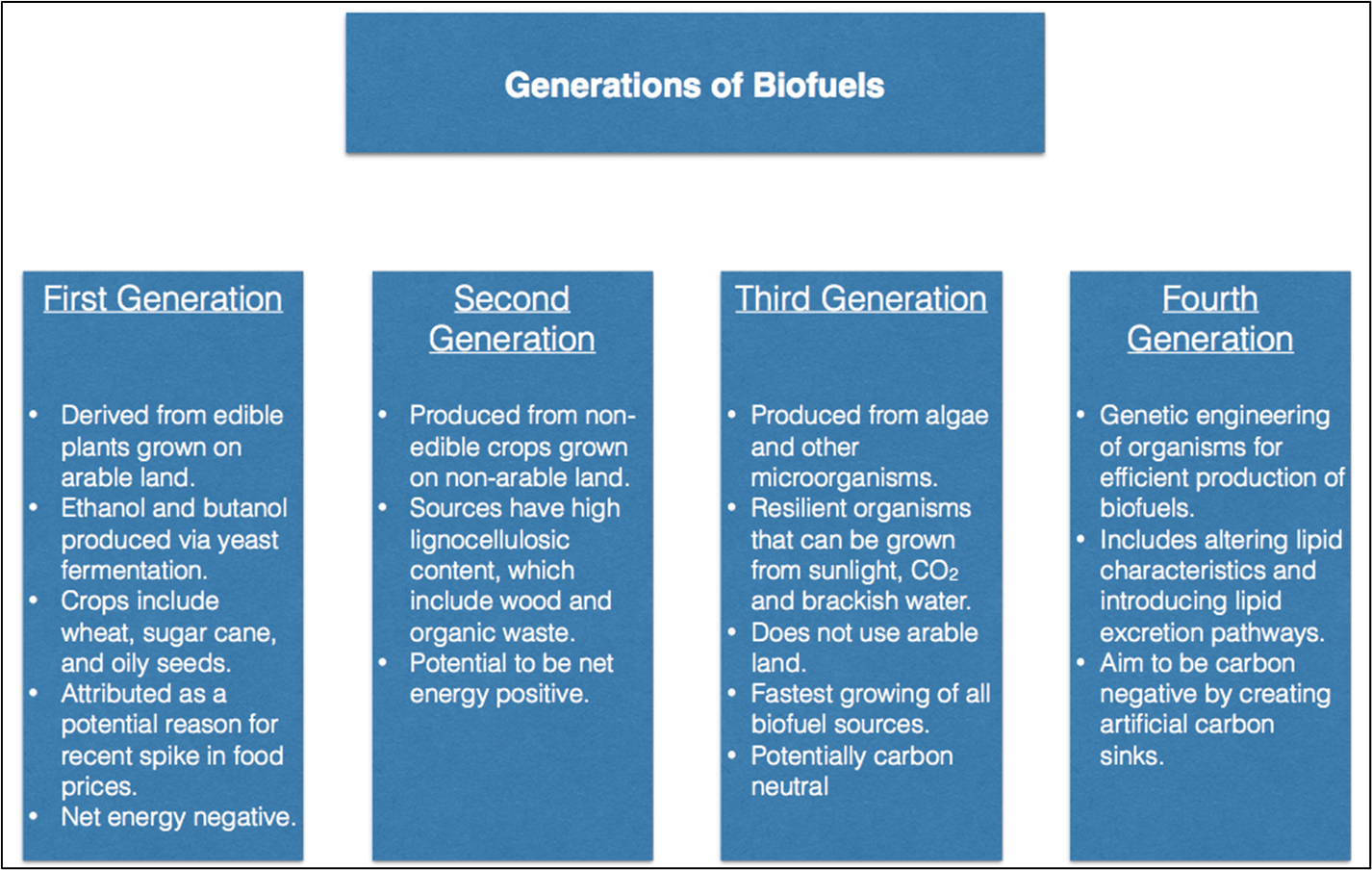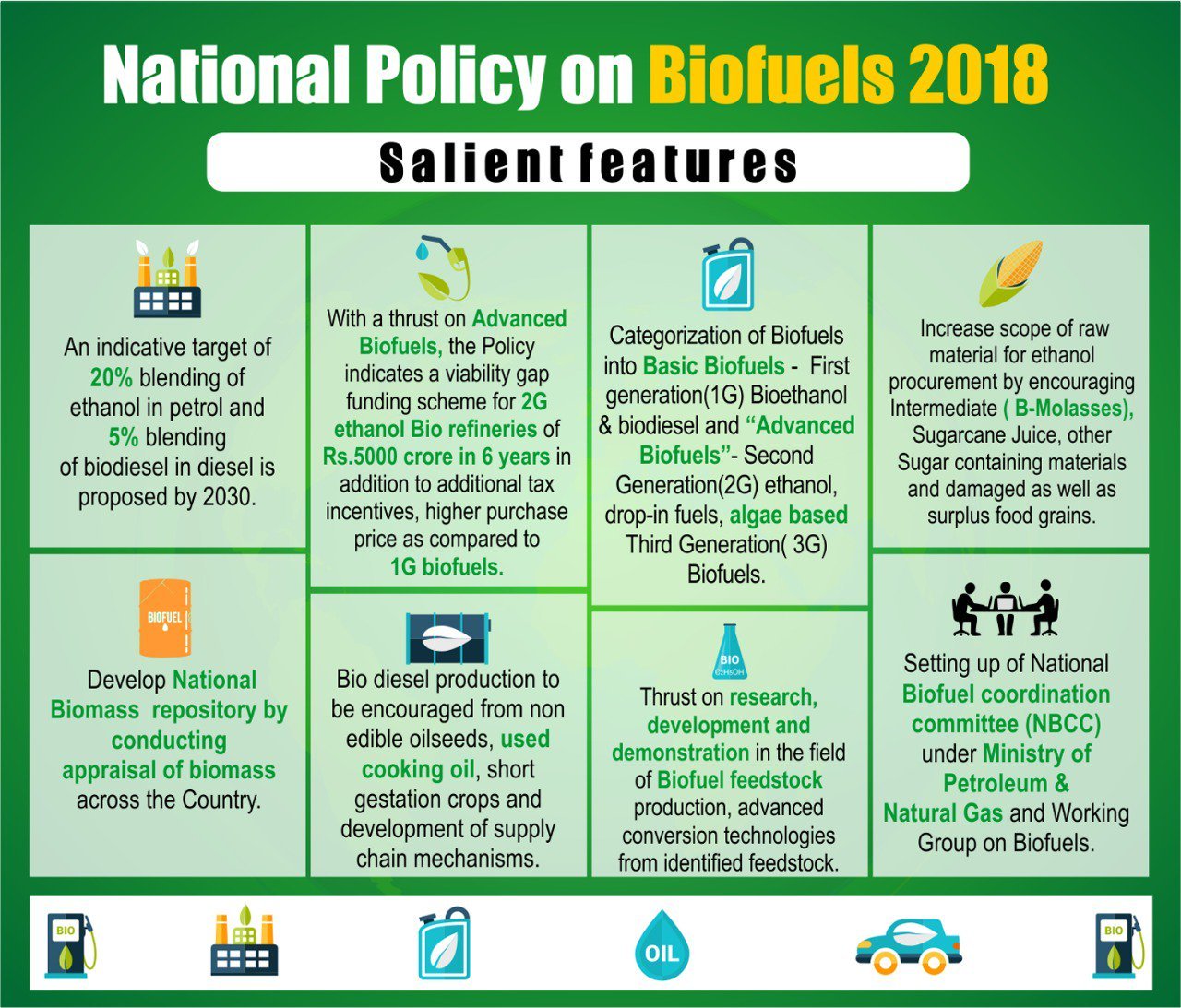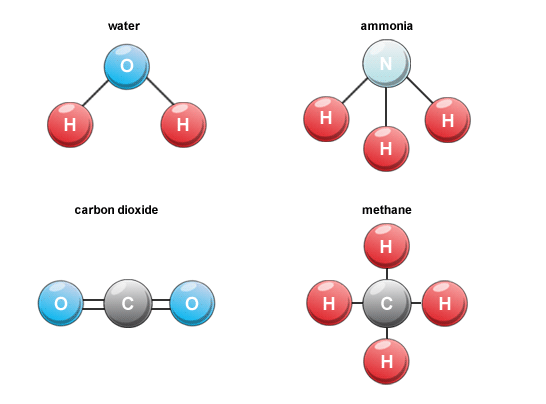
Biofuels, Important Biofuels, National Policy on Biofuels 2018
Subscribe to Never Miss an Important Update! Assured Discounts on New Products!
Must Join PMF IAS Telegram Channel & PMF IAS History Telegram Channel
Biofuels
- Any hydrocarbon fuel i.e. Solid, Liquid or Gas, that is produced from an organic matter which may be living or once living material, in a short period of time is considered a biofuel.
- Examples include:
- Solid: Wood, manure
- Liquid: Bioethanol and Biodiesel
- Gaseous: Biogas
- Biofuels can be produced from biomass, such as corn or sugar, vegetable oils or waste feedstocks.
- As biofuels emit less carbon dioxide (CO2) than conventional fuels they can be blended with existing fuels as an effective way of reducing CO2 emissions in the transport sector.
- Biofuels represent around 3% of road transport fuels in use around the world.
First Generation Biofuels
- First Generation biofuels are produced directly from food crops by abstracting the oils for use in biodiesel or producing bioethanol through conventional methods like fermentation.
- Crops such as wheat and sugar are the most widely used feedstock for bioethanol while rapeseed oil has proved a very effective crop for use in biodiesel.
- First generation biofuels have a number of associated problems.
- These biofuels can produce Negative Net energy gains, releasing more carbon in their production than their feedstock’s capture in their growth.
- The most contentious issue with first generation biofuels is ‘fuel vs food’.
- Biofuels from foodgrains has been blamed for the increase in food prices over the last couple of years.
Second Generation Biofuels
- They are produced from non-food crops such as wood, organic waste, food crop waste and specific biomass crops, therefore eliminating the main problem with first generation biofuels.
- Second Generation biofuels are also aimed at being more cost competitive in relation to existing fossil fuel.
- Life cycle assessments of second-generation biofuels have also indicated that they will increase Positive net energy gains over coming another of the main limitations of first-generation biofuels.
Third Generation Biofuels
- The Third Generation of biofuels takes advantage of specially engineered energy crops such as algae.
- The algae are cultured to act as a low-cost, high-energy and entirely renewable feedstock.
- It is predicted that algae will have the potential to produce more energy per acre than conventional crops.
- Algae can also be grown using land and water unsuitable for food production.
- A further benefit of algae-based biofuels is that the fuel can be manufactured into a wide range of fuels such as diesel, petrol and jet fuel.
- It is potentially carbon neutral (the same amount of carbon is absorbed and emitted).
Fourth Generation Biofuels
- Four Generation Bio-fuels are aimed at not only producing sustainable energy but also a way of capturing and storing CO2.
- Biomass materials, which have absorbed CO2 while growing, are converted into fuel using the same processes as second-generation biofuels.
- This process differs from second and third generation production as at all stages of production the carbon dioxide is captured using processes such as oxy-fuel combustion.
- The carbon dioxide can then be geo-sequestered by storing it in old oil and gas fields or saline aquifers.
- This carbon capture makes fourth generation biofuel production carbon negative rather than simply carbon neutral, as it is locks away more carbon than it produces.
- This system not only captures and stores carbon dioxide from the atmosphere but it also reduces CO2 emissions by replacing fossil fuels.


Some Important Biofuels
Bioethanol
- Bioethanol (aka ethanol or ethyl alcohol (C2H5OH)) is an alcohol produced from starch and sugar crops.
- It is commonly blended with petrol.
- Bioethanol is mainly produced by fermentation and by reacting ethylene with steam.
- Ethanol is a clear colourless liquid.
- It is biodegradable, low in toxicity and causes little environmental pollution.
- Ethanol burns to produce carbon dioxide and water.
- Ethanol is a high-octane fuel and has replaced lead as an octane enhancer in petrol.
- By blending ethanol with gasoline, we can also oxygenate the fuel mixture so it burns more completely and reduces polluting emissions.
Biodiesel
- It is produced through a biochemical process called “Transesterification.”
- Biodiesel is made from renewable sources such as vegetable/plant/animal oils for use in diesel engines.
- Vegetable oils are chemically called triglycerides (fats).
- Biodiesel comprises esters of long chain fatty acids derived from these oils.
- To make biodiesel, fats in the vegetable oil (triglycerides) are reacted with alcohol — usually methanol.
- In this reaction, glycerine (in triglycerides) is replaced by methanol to produce methyl ester (biodiesel).
- Biofuel development in India centres around the cultivation of Jatropha plant seeds — rich in oil (40%).
Biogas
- Biogas is created as a by-product of decomposing plant and animal waste in environments with low levels of oxygen: landfills, waste treatment facilities, and dairies.
- It is produced by anaerobic decomposition of organic matter.
- Biogas is made up primarily of methane and carbon dioxide (greenhouse gasses), thus the natural incentives are strong to keep biogas from entering the atmosphere.
Biobutanol
- Biobutanol is a four-carbon alcohol produced by the fermentation of biomass.
- The production of biobutanol can be carried out in ethanol production facilities.
- The primary use of biobutanol is as a fuel in internal combustion engines.
- Its properties are similar to that of gasoline.
- Some gasoline-powered vehicles can even use biobutanol without being modified.
- It can be blended with gasoline in concentrations up to 11.5% by volume.
- However, it has a lower energy content, on average 10-20%, than that of gasoline, which is a major disadvantage of biobutanol.
- Biobutanol exhibits the potential to reduce carbon emissions by 85% when compared to gasoline, thus making it a viable and suitable alternative to gasoline and gasoline-ethanol blended fuels.
Biohydrogen
- Biohydrogen can be produced using a number of processes such as pyrolysis, gasification, etc.
- Biohydrogen could be considered as valuable and alternative energy carrier to fossil fuels.
- However, economically feasible large-scale biohydrogen production is essential for the replacement of fossil fuels with biohydrogen.
Evolution of Indian Biofuels
|
1975 |
|
|
2002 |
|
|
2004 |
|
|
2005 |
|
|
2006 |
|
|
2007 |
|
|
2009 |
|
|
2018 |
|
Advantages of Biofuels
Less Flammable
- Biofuel is made from renewable resources and relatively less-flammable compared to fossil diesel.
Increases life of Vehicle Engine
- Biofuels are adaptable to current engine designs and perform very well in most conditions.
- They have higher cetane and better lubricating properties.
- This keeps the engine running for longer, requires less maintenance and brings down overall pollution.
Less Carbon Emission
- Biofuel causes less harmful carbon emission compared to standard diesel.
- Studies suggest that biofuels reduce greenhouse gases up to 65 percent.
Easy to Source
- Biofuels are made from many different renewable sources such as manure, waste from crops, corn, switchgrass, soybeans, algae and plants grown specifically for the fuel.
Economic Security
- If more people start shifting towards biofuels, a country can reduce its dependence on fossil fuels.
- Fuelling homes, businesses and vehicles with biofuels are less expensive than fossil fuels.
- More jobs will be created with a growing biofuel industry, which will keep our economy secure.
Lower Levels of Pollution
- Biofuels are biodegradable that reduces the possibility of soil contamination and contamination of underground water during transportation, storage or use.
Cost-Benefit
- As of now, biofuels cost the same in the market as gasoline does.
- However, the overall cost-benefit of using them is much higher.
- They are cleaner fuels, which means they produce fewer emissions on burning.
- With the increased demand, they have the potential of becoming cheaper in the future as well.
Disadvantages of Biofuels
High Cost of Production and Future Price
- High Cost of Production: Biofuels are quite expensive to produce in the current market. The interest and capital investment being put into biofuel production is fairly low.
- Constantly rising prices may make the use of biofuels as harsh on the economy as the rising gas prices are doing right now.
Industrial Pollution
- The carbon footprint of biofuels is less than the traditional forms of fuel when burnt.
- However, the process with which they are produced makes up for that.
- Large scale industries meant for churning out biofuel are known to emit large amounts of emissions and cause small scale water pollution as well.
- Unless more efficient means of production are put into place, the overall carbon emission does not get a very big dent in it. It also causes an increase in NOx.
Changes in Land Use and Pollution
- Biofuel production can encourage monoculture.
- If the land is used to grow a biofuel feedstock, it has to be cleared of native vegetation, which then leads to ecological damage done in three ways.
- First, the damage is caused by destroying local habitant and reduces the overall health of natural resources of the region.
- The native forest is almost always better at removing CO2 from the atmosphere than a biofuel feedstock partly because the CO2 remains trapped and is never released by burning as with fuel stock.
- Secondly, the damage is done in the carbon debt created.
- Estimates have shown that deforesting native land can actually produce a carbon debt that can take up to 500 years to repay.
- Finally, changing land to an agricultural status almost always means fertilizers are going to be used to get the most yields per area. The problem is runoff and other agricultural pollution.
- Thus, creating more farmland is likely to damage waterways and energy used in treatment plants, and other mitigation strategies lead to an even larger carbon debt.
Biofuel is less suitable for use in low temperatures
- It is more likely to attract moisture than fossil diesel, which creates problems in cold weather.
- It also increases microbial growth in the engine that clogs the engine filters.
National Policy on Biofuels 2018
The Highlights of the Policy are:
- As per the policy, GOI aims at increasing the utilization of biofuels in the energy and transportation sectors by promoting the production of biofuels from domestic feedstock in the coming decade.
- Larger goals such as the adoption of green fuels, national energy security, fighting CC, generating employment, etc. would be facilitated through this policy.
- MNRE has set an indicative target of 20% blending of ethanol in petrol and 5% blending of biodiesel in diesel to be achieved by 2030. (The percentage of the same currently stands at around 2% for petrol and less than 0.1% for diesel).
- The Ministry has also outlined a roadmap for the efficient realisation of the policy which entails the following steps:
- Improve the current production of ethanol and biodiesel by increasing domestic production
- Set up second-generation (2G) biorefineries
- Develop new feedstock for biofuels
- New technological developments to improve biofuel production
- Facilitate the blending of biofuels with conventional fuels
- The Policy categorises biofuels as: –
- Basic Biofuels – First Generation (1G) bioethanol & biodiesel and
- Advanced Biofuels – Second Generation (2G) ethanol, Municipal Solid Waste to drop-in fuels,
- Third Generation (3G) biofuels, bio-CNG etc.
- Categorization enables extension of appropriate financial and fiscal incentives under each category.
- The Policy expands the scope of raw material for ethanol production by allowing use of-
- Sugarcane Juice, Sugar containing materials like Sugar Beet, Sweet Sorghum, Starch containing materials like Corn, Cassava, etc.
- Damaged food grains like wheat, broken rice, Rotten Potatoes, unfit for human consumption.
- Surplus food grains with the approval of National Biofuel Coordination Committee.
- Use of damaged food grains and surplus food grains for production of ethanol will increase its availability for Ethanol Blended Petrol (EBP) Programme.
- Bioethanol: Fuels produced from materials that have
- sugar such as sugar cane, sugar beet, sweet sorghum, etc.;
- materials that have starch such as corn, cassava, rotten potatoes, algae, etc.;
- cellulosic materials such as bagasse, waste wood, agricultural/forestry residues, etc. or other renewable industrial waste fall in this category.
- Biodiesel: This category includes methyl or ethyl ester of fatty acids derived from non-edible vegetable oil, acid oil, used cooking oil, animal fat and bio-oil.
- Advanced biofuels: Second-generation (2G) ethanol, drop-in fuels, algae-based 3G biofuels, bio-CNG, bio-methanol, dimethyl ether (DME) derived from bio-methanol, bio-hydrogen, drop-in fuels produced from municipal solid waste (MSW), etc. have been included in this category.
- Drop-in fuels: These are fuels derived from biomass, Agri-residues, MSW, plastic wastes, etc. that can be used in existing engines without having to modify their fuel distribution system.
- Bio-CNG: These fuels are purified form of biogas produced from agricultural residues, dung, food waste, sewage water but their composition and energy potential are comparable to fossil-based natural gas.
- As a part of the policy, the government will also undertake the following steps to foster the adoption of biofuels.
- Through the Ethanol Blended Petrol (EBP) Programme, ethanol produced from various types of feedstocks would be blended with petrol.
- Second-generation (2G) ethanol technologies would be developed and commercialized.
- Through the Biodiesel Blending Programme, biodiesel would be blended with diesel.
- Drop-in fuels derived from MSW, different types of industrial wastes, biomass, etc. would be emphasized.
- Along with them, advanced biofuels such as bio-CNG, bio-methanol, DME, bio-hydrogen, bio-jet fuel, etc. would also be emphasized.
- The Ministry also plans on creating a ‘National Biomass Repository’ through a nation-wide appraisal program which will help ensure availability of biofuels produced from domestic feedstock.
- Through the National Policy on Biofuels, 2018, the government will undertake various financial as well as fiscal measures from time to time to ensure effective development, promotion and adoption of biofuels.
- With a thrust on Advanced Biofuels, the Policy indicates a viability gap funding scheme for 2G ethanol Bio refineries of Rs.5000 crore in 6 years in addition to additional tax incentives, higher purchase price as compared to 1G biofuels.
- The Policy allows use of surplus food grains for production of ethanol for blending with petrol with the approval of National Biofuel Coordination Committee.


















Sir/Mam its a request to provide pdf to such topics.